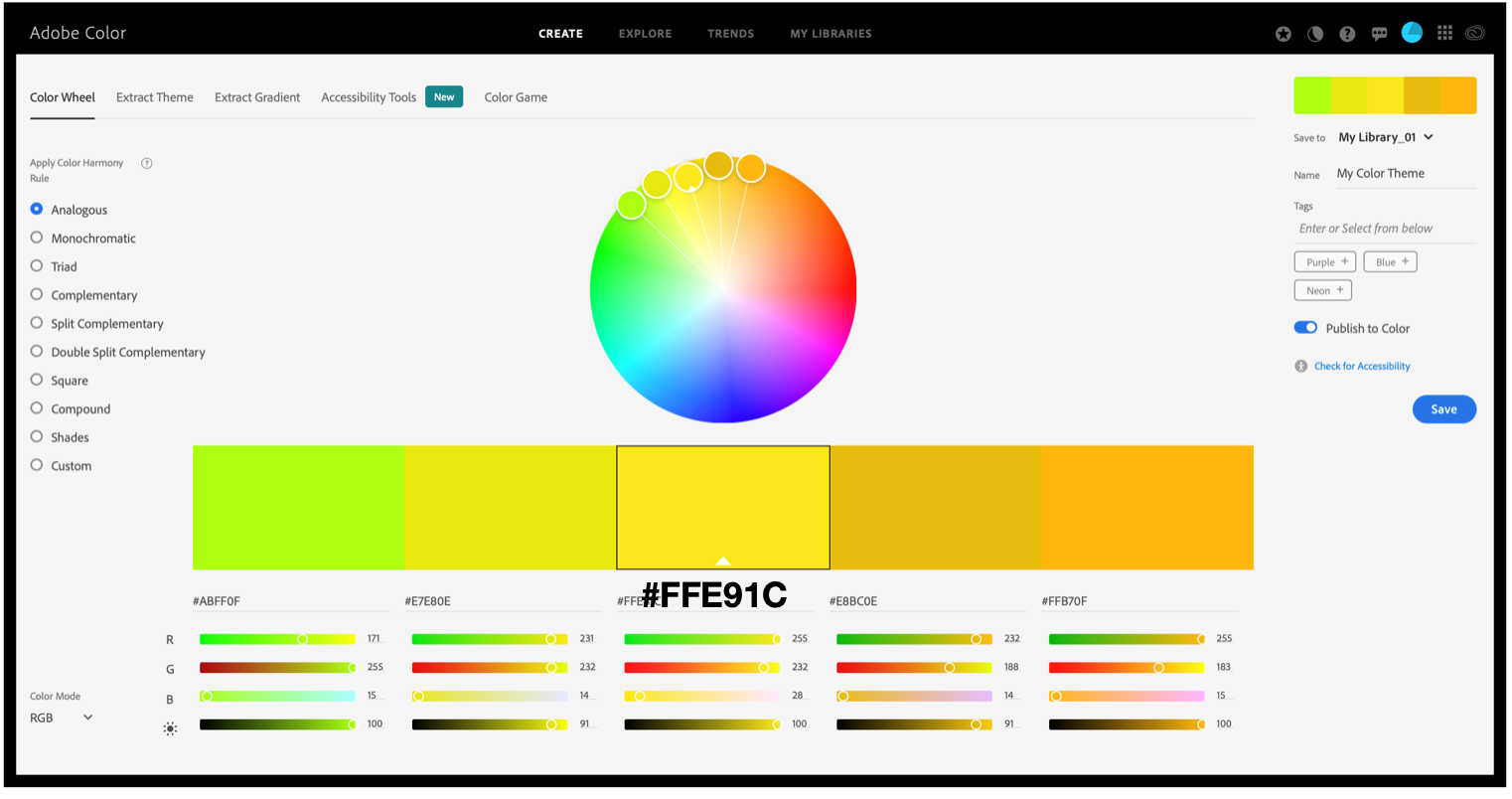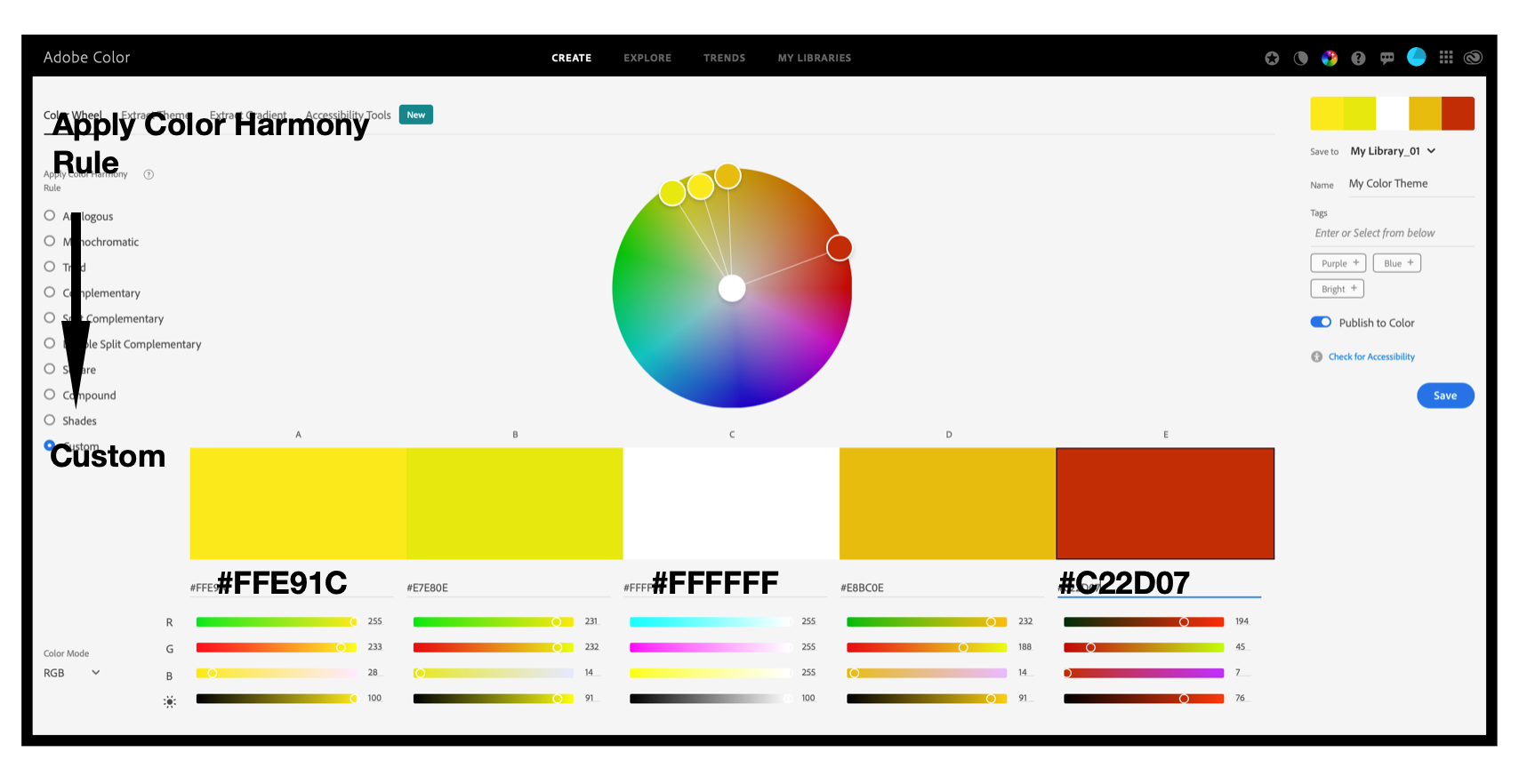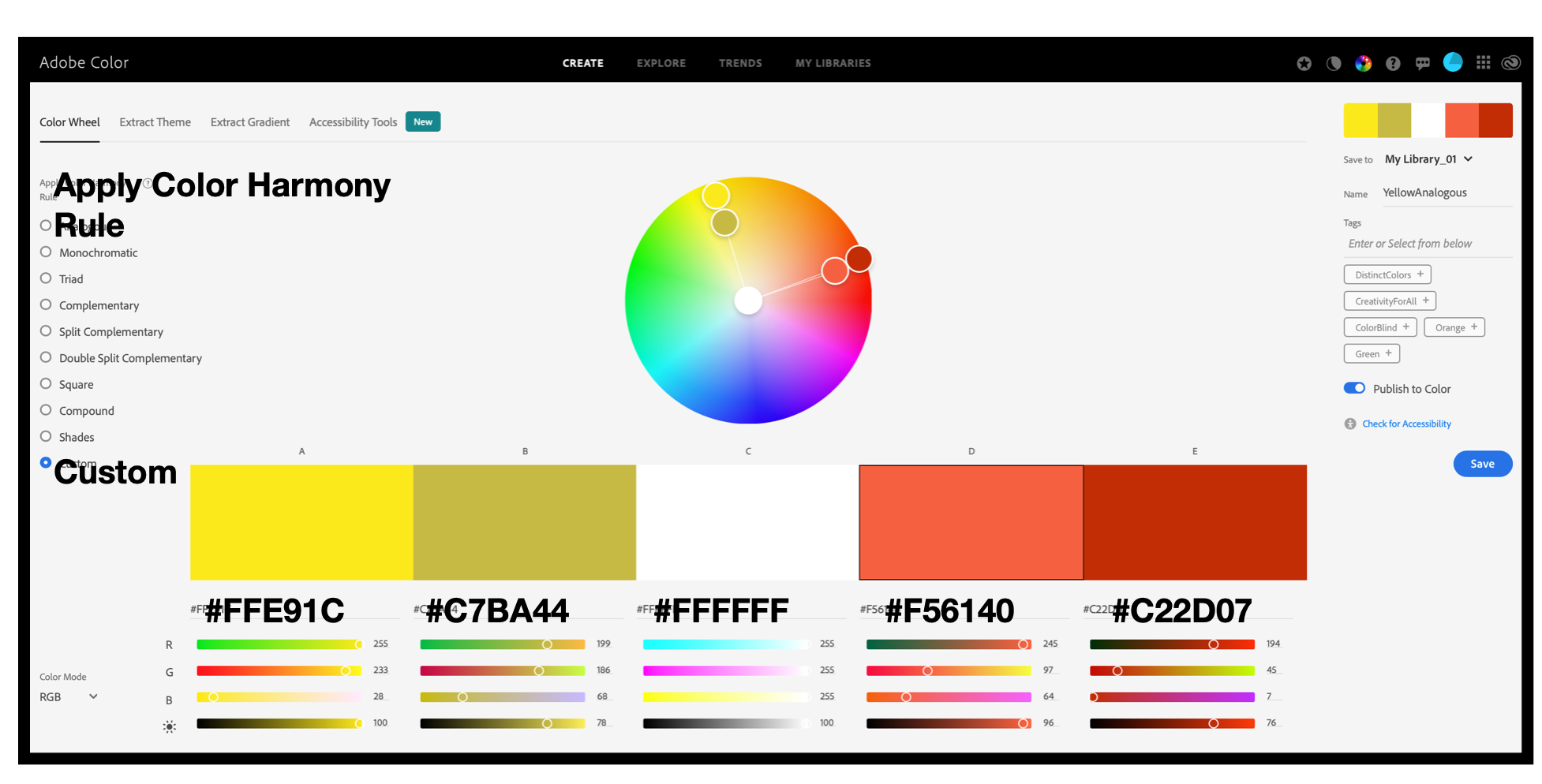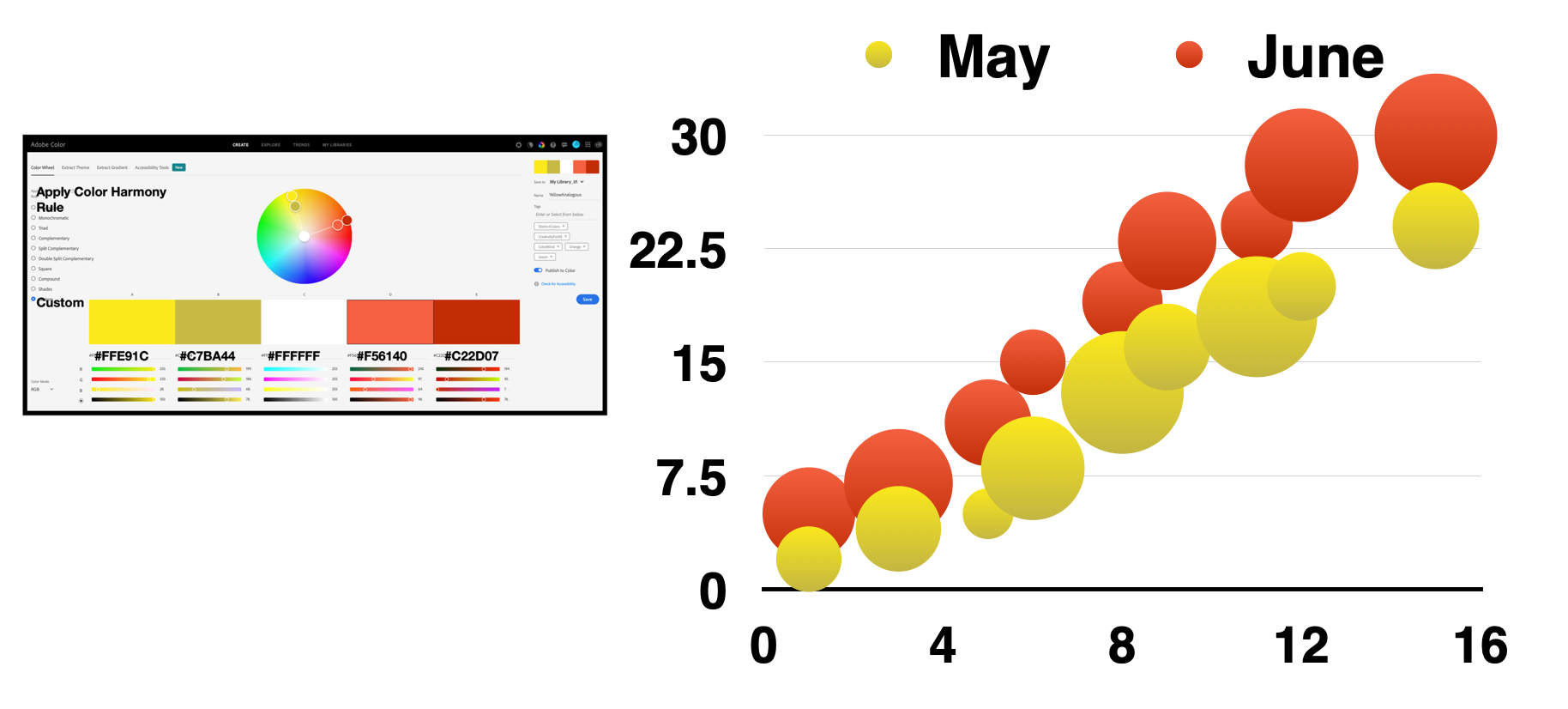小程序點擊地圖氣泡獲取氣泡
Combining two colors that are two steps apart on the Color Wheel creates a Diad Color Harmony. This Color Harmony is one of the lesser used ones. I decided to cover it here to add variety to your options for colorizing visualizations.
在色輪上將相距兩步的兩種顏色組合在一起,將創建Diad色彩協調。 色彩和諧是使用較少的一種。 我決定在這里進行介紹,以為您的可視化著色選項增加多樣性。
As noted in my earlier Nightingale writings, color harmony is the process of choosing colors on a Color Wheel that work well together in the composition of an image. “The Blues of Color Harmony” noted the similarities between color harmony and musical harmony. Here, I will delve further into color theory by discussing the Diad Color Harmony and show how Color Gradients can be created.
正如我在夜鶯的早期著作中所提到的,色彩協調是在色輪上選擇色彩的過程,這些色彩在圖像的合成中可以很好地協同工作。 “ 色彩和諧的藍調 ”指出了色彩和諧與音樂和諧之間的相似之處。 在這里,我將通過討論Diad顏色和聲來進一步研究顏色理論,并說明如何創建顏色漸變。
The Adobe Color web app will be used to create a Diad color theme that will then be applied to a bubble chart example. The bubbles effect for each variable will be produced with Color Gradients. A flat, or circle, bubble chart alternative will also be shown. To address individuals with limited color vision, the data visualization examples are checked with the Color Blindness Simulator — Coblis. Both Adobe Color and Coblis are freely available online tools for your continued use.
Adobe Color Web應用程序將用于創建Diad顏色主題,然后將其應用于氣泡圖示例。 每個變量的氣泡效果將通過“顏色漸變”產生。 還將顯示平面或圓形氣泡圖替代方案。 為了解決色覺受限的問題,請使用“ 色盲模擬器 -Coblis”檢查數據可視化示例。 Adobe Color和Coblis都是免費的在線工具,供您繼續使用。

Reviewing Color Harmony Concepts
回顧色彩和諧的概念
Isaac Newton is credited with creating the Color Wheel concept when he closed the linear color spectrum into a color circle in the early 1700s. Over the centuries, artists and color scientists amplified his concept to include color harmonies. Below I show the Red-Green-Blue Color Wheel based on the concept that Red, Green and Blue (RGB) are the color primaries for viewing displays like what we see on our desktop and mobile devices. I also show the Diad Harmony of Yellow and Red that is going to used further in this writing.
艾薩克·牛頓(Isaac Newton)在1700年代初將線性色譜圖譜封閉在色環中時,就創造了色輪概念。 幾個世紀以來,藝術家和色彩科學家將他的概念擴大到包括色彩和諧。 在下面,我基于紅色,綠色和藍色(RGB)是用于查看顯示器(如我們在臺式機和移動設備上看到的顏色)的原色的概念,顯示了紅綠藍色輪。 我還展示了黃色和紅色的Diad和聲,它將在本文中進一步使用。


用Adobe Color創建黃紅色Diad和諧 (Creating the Yellow Red Diad Harmony with Adobe Color)
Color Wheel based selection tools, like Adobe Color, automatically calculate a set of standard color harmonies. There is also a standard convention where five colors define a theme. The Diad color harmony, however, is not standard. So, the “Custom” function is used here to build a “Yellow Diad” theme.
基于色輪的選擇工具(如Adobe Color)會自動計算一組標準的顏色和聲。 還有一個標準約定,其中五種顏色定義了一個主題。 但是,Diad色彩協調不是標準的。 因此,此處使用“自定義”功能來構建“黃色Diad”主題。
The intended visualization in this writing is a bubble chart. To create a three dimensional “Bubbles” effect, I will use gradient fills. Gradient fills gradually change one color into another. The Yellow Diad theme has two base colors, a Yellow and a Red. For the Yellow gradient fill, a Yellow tone color will gradually transition into the Key Yellow hue. The Red gradient will be produced with a Red hue fading into a Red tint element. Four colors are thus required to accomplish the gradient fill tasks.
本文中預期的可視化效果是氣泡圖。 為了創建三維“氣泡”效果,我將使用漸變填充。 漸變填充逐漸將一種顏色變為另一種顏色。 Yellow Diad主題有兩種基本顏色,黃色和紅色。 對于黃色漸變填充,黃色調顏色將逐漸過渡為關鍵黃色調。 紅色漸變將產生,紅色色調會淡入紅色色調元素。 因此需要四種顏色來完成漸變填充任務。
Adobe Color, however, desires five colors to build a given color theme. As a result, I will add a White #FFFFFF color as the center color of the final Yellow Diad theme. This will allow the Adobe Color app to feel satisfied. These steps will become more clear as the Yellow Diad theme is built. So, let’s get started.
但是,Adobe Color需要五種顏色來構建給定的顏色主題。 結果,我將添加白色#FFFFFF顏色作為最終的Yellow Diad主題的中心顏色。 這將使Adobe Color應用程序感到滿意。 隨著“ 黃色鉆石”主題的建立,這些步驟將變得更加清晰。 因此,讓我們開始吧。
The first step is to select a Key or Base color. For these efforts, I will select a Yellow noted in Web Hex notation as #FFE91C. Entering #FFE91C as the middle color in Adobe Color yields a family ranging from Green Yellow to Yellow Orange.
第一步是選擇鍵或基色。 為了這些努力,我將選擇一種以Web十六進制表示法表示的黃色作為#FFE91C。 在Adobe Color中輸入#FFE91C作為中間色會產生從綠黃色到黃橙色的系列。

This forms an Analogous Color Harmony. An Analogous Color Harmony is defined as three or more colors that are adjacent to each other on the Color Wheel. The resulting Analogous Harmony in the Key of Yellow #FFE91C is shown on the left.
這形成了類似的色彩和聲。 類比色彩協調定義為在色輪上彼此相鄰的三種或更多種顏色。 左側顯示了黃色鍵“ FFE91C”中得到的類似和聲。

Next, the “Custom” option is selected under the “Apply Color Harmony Rule” menu, as shown on the left.
接下來,在“應用顏色協調規則”菜單下選擇“自定義”選項,如左圖所示。
To create the Yellow Diad theme, I use a Red #C22D07 hue that is two steps clockwise from the Base or Key Yellow #FFE91C color in the Adobe Color app.
要創建黃色Diad主題,我使用了紅色#C22D07色相,該色相距Adobe Color應用程序中的“基色”或“基色黃色”#FFE91C顏色順時針兩步。

As noted earlier, only four colors are needed for the Yellow Diad theme. Here, I enter a neutral White #FFFFFF as the center color with Yellow #FFE91C on the far left and Red #C22D07 on the far right. These results are shown on the left.
如前所述, Yellow Diad主題僅需要四種顏色。 在這里,我輸入一個中性的白色#FFFFFF作為中心顏色,最左側是黃色#FFE91C,最右側是紅色#C22D07。 這些結果顯示在左側。
There are now three colors in the Yellow Diad theme: Yellow #FFE91C, Red #C22D07 and the White #FFFFFF center place holder. Our next step is to select the colors to support building the three dimensional “Bubbles” effect. For the Yellow gradient fill, a Yellow tone color will gradually transition into the Key Yellow #FFE91C element. The Red gradient will be produced with the Red #C22D07 fading into a Red tint element.
黃色主題中現在有三種顏色:黃色#FFE91C,紅色#C22D07和白色#FFFFFF中心占位符。 我們的下一步是選擇顏色,以支持建立三維“氣泡”效果。 對于黃色漸變填充,黃色調將逐漸過渡為Key Yellow#FFE91C元素。 紅色漸變會隨著紅色#C22D07淡入紅色色調元素而產生。

As noted in my previous “The Blues of Color Harmony” writing, a tone is created when a hue is mixed with Gray while a tint is defined as a hue mixed with White. These color gradient fill specifics are illustrated on the left.
正如我之前的“ 藍色調和調” 一書中提到的那樣,當色調與灰色混合而色調被定義為與白色混合的色調時,會創建一個音調。 這些顏色漸變填充的詳細信息顯示在左側。

Returning to creating the Yellow Diad theme with Adobe Color, using Yellow #C7BA44 just underneath the hue Yellow #FFE91C, a tone element is obtained. Using Red #F56140 just underneath the hue Red #C22D07, a tint is obtained. This completes the Yellow Diad theme. The results are shown on the left.
返回使用Adobe Color創建Yellow Diad主題,使用黃色#FFE91C下方的黃色#C7BA44,獲得色調元素。 使用紅色#C22D07下方的紅色#F56140,可獲得色彩。 這就完成了“ 黃色鉆石”主題。 結果顯示在左側。

評估顏色主題的顏色不足 (Evaluating for Color Deficiencies of the Color Theme)
In humans there are three types of photoreceptors or cones where each is sensitive to different parts of the visual spectrum of light to facilitate rich color vision. If one or more of the set of cones does not perform properly, a color deficiency results. A red cone deficiency is classified as Protanopia. A green cone deficiency is classified as Deuteranopia. A blue cone deficiency is classified as Tritanopia.
在人類中,有三種類型的感光器或視錐細胞,其中的每一種對光的光譜的不同部分敏感,以促進豐富的色彩視覺。 如果一組錐體中的一個或多個錐體不能正常工作,則會導致顏色不足。 紅錐缺乏癥被歸類為Protanopia。 綠錐缺乏癥被歸類為Deuteranopia。 藍錐缺乏癥被分類為Tritanopia。
Adobe Color has recently added an “Accessibility Tools” function that provides tests for Protanopia, Deuteranopia and Tritanopia of color themes.
Adobe Color最近添加了“可訪問性工具”功能,該功能可用于測試Protanopia,Deuteranopia和Tritanopia顏色主題。

This allows us to conduct preliminary color deficiency tests before actual visualizations are created.
這使我們能夠在創建實際的可視化效果之前進行初步的色差測試。
These preliminary results indicate that Yellow Diad passes these checks. These results are shown on the left.
這些初步結果表明, Yellow Diad通過了這些檢查。 這些結果顯示在左側。

使用顏色漸變構建氣泡圖可視化 (Building a Bubble Chart Visualization with Color Gradients)
The next step is to apply the Yellow Diad theme to building a Bubble Chart visualization. Software tools such as Microsoft Excel or Word, Apple Numbers or Pages, Google Docs, Tableau Software and many others can help generate this example.
下一步是將Yellow Diad主題應用于氣泡圖可視化。 諸如Microsoft Excel或Word,Apple Numbers或Pages,Google Docs,Tableau Software等軟件工具可以幫助生成此示例。
Using the Yellow #C7BA44 tone and the pure hue of Yellow #FFE91C, a Yellow gradient for the first data set in the Bubble chart is created. Using the Red #F56140 tint and the pure hue of Red #C22D07, a Red gradient for the second data set is developed. These two processes are shown below.
使用黃色#C7BA44色調和黃色#FFE91C的純色,為氣泡圖表中的第一個數據集創建黃色漸變。 使用紅色#F56140色調和紅色#C22D07的純色,為第二個數據集開發了紅色漸變。 這兩個過程如下所示。

A Bubble Chart data visualization with the Yellow and Red gradients can now be generated. These results are shown below.
現在可以生成帶有黃色和紅色漸變的氣泡圖數據可視化。 這些結果如下所示。


評估數據可視化中的色彩缺陷 (Evaluating for Color Deficiencies in the Data Visualization)
For the Bubble Chart visualization, I use the online Color Blindness Simulator, Coblis, to evaluate for color deficiencies. The Yellow Diad Bubble Chart passes color deficiency checks. Individuals with Protanopia, red cone color deficiency, Deuteranopia, green cone deficiency or Tritanopia, blue cone color deficiency, can distinguish between the color elements in the data visualization. These results are shown below.
對于氣泡圖可視化,我使用在線色盲模擬器 Coblis來評估顏色缺陷。 黃色Diad氣泡圖通過顏色不足檢查。 患有Protanopia,紅錐色缺失,Deuteranopia,綠錐色缺失或Tritanopia,藍錐色缺失的個體可以在數據可視化中區分顏色元素。 這些結果如下所示。


帶有黃色Diad主題的替代氣泡圖 (The Alternative Bubble Chart with the Yellow Diad Theme)
It is also possible to create an alternative visualization with the Yellow Diad theme that yields a “flat” Bubble Chart. Here, only the Yellow(#FFE91C) and Red (#C22D07) hues are applied. These results are shown below.
還可以使用“黃色Diad”主題創建替代的可視化效果,從而生成“平坦”氣泡圖。 在此,僅應用黃色(#FFE91C)和紅色(#C22D07)色調。 這些結果如下所示。


評估氣泡圖可視化的顏色不足 (Evaluating for Color Deficiencies for the Alternative Bubble Chart Visualization)
The color deficiency checks for the alternative Yellow Diad Bubble Chart example are presented below. This data visualization successfully passes these tests. Individuals with Protanopia, red cone color deficiency, Deuteranopia, green cone deficiency or Tritanopia, blue cone color deficiency, can distinguish between the color elements in the data visualization.
下面顯示了替代的“黃色Diad氣泡圖”示例的顏色不足檢查。 數據可視化成功通過了這些測試。 患有Protanopia,紅錐色缺陷,Deuteranopia,綠錐色缺陷或Tritanopia,藍錐色缺陷的個體可以在數據可視化中區分顏色元素。


結束語 (Concluding Remarks)
There are many approaches to building color schemes for data visualizations. This writing focused on building a Diad Color Harmony with the Key color of Yellow(#FFE91C) and a Red (#C22D07) hue. The concept of Color Gradients using Tints and Tones was also introduced. The resulting Yellow Diad theme was applied to two Bubble Chart visualization examples. One solution included a set of three-dimensional bubbles created with the Color Gradients. The second visualization example was a “Flat” Bubble Chart using the Key color of Yellow (#FFE91C) and a Red (#C22D07) hue. These two data visualizations are shown below.
有許多方法可以構建用于數據可視化的配色方案。 本書著重于構建黃色(#FFE91C)和紅色(#C22D07)色調的Diad顏色和聲。 還介紹了使用“色調和色調”的“顏色漸變”的概念。 產生的Yellow Diad主題應用于兩個Bubble Chart可視化示例。 一個解決方案包括使用“顏色梯度”創建的一組三維氣泡。 第二個可視化示例是使用黃色(#FFE91C)和紅色(#C22D07)的鍵色的“平面”氣泡圖。 這兩個數據可視化如下所示。

The Adobe Color web app was used to create the Yellow Diad theme and perform initial color deficiency checks on the color theme. The data visualization examples were checked with the Color Blindness Simulator — Coblis. The color theme and data visualizations passed these color deficiency checks. This sample data set shows higher values for June, and it is visible in both cases.
Adobe Color Web應用程序用于創建Yellow Diad主題并對該顏色主題執行初始顏色不足檢查。 數據可視化示例使用色盲模擬器 Coblis進行了檢查。 顏色主題和數據可視化通過了這些顏色缺陷檢查。 此示例數據集顯示6月的較高值,并且在兩種情況下均可見。
For further discussions on my approaches, please see my prior Nightingale articles noted below as well as my 2016 book on “Applying Color Theory to Digital Media and Visualization” published by CRC Press.
有關我的方法的進一步討論,請參閱下面提到的我先前在Nightingale上發表的文章,以及我在CRC Press出版的2016年有關“ 將色彩理論應用于數字媒體和可視化 ”的書。

Theresa-Marie Rhyne is a Visualization Consultant with extensive experience in producing and colorizing digital media and visualizations. She has consulted with the Stanford University Visualization Group on a Color Suggestion Prototype System, the Center for Visualization at the University of California at Davis and the Scientific Computing and Imaging Institute at the University of Utah on applying color theory to Ensemble Data Visualization. Prior to her consulting work, she founded two visualization centers: (a) the United States Environmental Protection Agency’s Scientific Visualization Center and (b) the Center for Visualization and Analytics at North Carolina State University.
Theresa-Marie Rhyne是一位可視化顧問,在制作和著色數字媒體和可視化方面具有豐富的經驗。 她曾在色彩建議原型系統,斯坦福大學戴維斯分校的加利福尼亞大學可視化中心以及猶他大學的科學計算與成像研究所的斯坦福大學視覺化小組中就將色彩理論應用于集合數據視覺化方面進行過咨詢。 在從事咨詢工作之前,她建立了兩個可視化中心:(a)美國環境保護局的科學可視化中心,以及(b)北卡羅萊納州立大學的可視化和分析中心。

翻譯自: https://medium.com/nightingale/bubbles-on-a-diad-da5f299dfcd9
小程序點擊地圖氣泡獲取氣泡
本文來自互聯網用戶投稿,該文觀點僅代表作者本人,不代表本站立場。本站僅提供信息存儲空間服務,不擁有所有權,不承擔相關法律責任。 如若轉載,請注明出處:http://www.pswp.cn/news/391581.shtml 繁體地址,請注明出處:http://hk.pswp.cn/news/391581.shtml 英文地址,請注明出處:http://en.pswp.cn/news/391581.shtml
如若內容造成侵權/違法違規/事實不符,請聯系多彩編程網進行投訴反饋email:809451989@qq.com,一經查實,立即刪除!)







)
)





)



